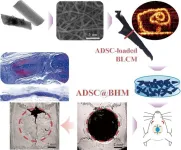Revolutionary tubular scaffolds boost stem cell-driven bone regeneration in skull defects
2024-09-12
(Press-News.org)
Scientists from Sun Yat-sen University's School of Biomedical Engineering have developed groundbreaking tubular scaffolds made from electrospun membranes, which significantly enhance bone regeneration in critical skull defects. These scaffolds, designed to mimic natural bone structures, create an ideal environment for adipose-derived stem cells (rADSCs) to thrive and accelerate healing. By integrating advanced materials like polycaprolactone, PLGA, and nano-hydroxyapatite, the researchers achieved remarkable results in both lab and animal studies, paving the way for innovative treatments in bone defect repair. This study marks a major leap forward in tissue engineering and regenerative medicine.
Critical-sized bone defects pose a significant challenge in the medical field. Traditional treatments using autografts and allografts are limited by donor scarcity, size mismatches between grafts and defect areas, and immune rejection, hindering widespread application. Bone tissue engineering offers a new solution by combining cells with biomaterials. Adipose-derived stem cells (ADSCs) have gained attentions in bone regeneration research due to their easy accessibility and strong osteogenic differentiation potential. However, direct injection of ADSCs results in short survival time, whereas combining them with scaffold materials significantly enhances in vivo retention and bone regeneration performance. Current research employs techniques such as electrospinning and 3D printing to fabricate scaffolds that mimic bone, substantially promoting bone regeneration. Integrating chemical signals like growth factors with the physical properties of scaffolds can further enhance the osteogenic differentiation of ADSCs. Despite these advances, limitations still exist in mimicking the hierarchical structure of bone, necessitating further optimization of scaffold design and combination strategies to improve clinical outcomes in bone regeneration.
The Solution: Researchers from School of Biomedical Engineering at Sun Yat-sen University have developed multilayer composite nanofibrous membranes containing polycaprolactone (PCL), poly(lactic-co-glycolic acid) (PLGA), and nano-hydroxyapatite (HAp) using electrospinning technology. Under conditions where the bilayer thickness ratio was 1:2 and the initial total thickness was 2.5 μm, BLCMs could spontaneously deform into 3D scaffolds under certain incubation conditions after being cut into structural units of specific shapes. These scaffolds effectively simulate bone and provide a suitable microenvironment for rADSCs to promote bone regeneration.
The Future: The constructed materials exhibit excellent capabilities in promoting rADSC proliferation and osteogenic differentiation, demonstrating significant potential for bone regeneration. Notably, the tubular units enhanced the effects of rADSCs on bone regeneration, and the potential relations of VEGF, BMP-2, and the 3D fibrous structure on promoting osteogenesis of rADSCs were clarified in this study. Future research should further investigate the fabrication of fibrous membrane scaffolds and the mechanism of the loaded MSCs on bone regeneration.
The Impact: This study developed multilayer composite nanofibrous tubular scaffolds using electrospinning technology, which effectively mimic bone structures and provide an optimal microenvironment for rADSCs to promote bone regeneration. Both in vitro and in vivo experimental results indicate that the constructed fibrous membranes hold significant potential for treating bone defects, offering a promising approach for bone regeneration.
This work has been recently published in the online edition of Materials Futures, a prominent international journal in the field of interdisciplinary materials science research.
Reference:
Huamin Jiang, Zhaoyi Lin, Jinze Li, Ting Song, Hongyun Zang, Pengwen Li, Jiarun Li, Wenyi Hou, Jianhua Zhou, and Yan Li, “rADSC-loaded tubular units composed of multilayer electrospun membranes promoted bone regeneration of critical-sized skull defects” 2024, DOI: 10.1088/2752-5724/ad66ea
END
[Attachments] See images for this press release:

ELSE PRESS RELEASES FROM THIS DATE:
2024-09-12
Nobel laureate Pierre Agostini, winner of the 2023 prize in physics, will headline a special two-day event hosted by the University of Tokyo on Sept. 26-27. The keynote lecture by Agostini, renowned for this pioneering work in attosecond science, will be part of a larger symposium bringing together researchers from around the world to celebrate the university’s planned Attosecond Laser Facility (ALFA), and discuss the latest developments and future directions of attosecond science.
Have you taken a photo of a fast-moving animal or vehicle and noticed how blurry the subject can be? This is likely because the faster a moving subject is, the faster the camera’s shutter needs ...
2024-09-11
Toronto, ON, September 11, 2024 — A single dose of the Modified vaccinia Ankara-Bavarian Nordic (MVA-BN) was 58% effective in protecting again mpox infection, according to a new study published in BMJ.
Researchers from ICES, Public Health Ontario, and the MAP Centre for Urban Health Solutions at St. Michael’s Hospital of Unity Health Toronto have conducted a target trial emulation to estimate the effectiveness of the mpox vaccine.
During the mpox outbreak in 2022, Ontario, Canada introduced the vaccine ...
2024-09-11
One dose of modified vaccinia Ankara-Bavarian Nordic (MVA-BN) smallpox vaccine is moderately effective in preventing mpox infection and should be made available to communities at risk, finds a study published by The BMJ today.
With mpox infections rising again across the globe, the researchers say these findings “strengthen the evidence that MVA-BN is effective at preventing mpox infection and should be made available and accessible to communities at risk.”
No randomised clinical trials of vaccination against mpox have been conducted. Estimates of the effectiveness of a single dose of vaccination from observational studies range from ...
2024-09-11
More than half of the experts on the UK government’s nutrition advisory panel have links to the food industry, reveals an investigation by The BMJ today.
At least 11 of the 17 members of the Scientific Advisory Committee on Nutrition (SACN) have conflicts of interest with the likes of Nestle, sugar manufacturer Tate and Lyle, and the world’s largest ice cream producer, Unilever, reports freelance journalist Sophie Borland.
And at least six out of the 11 members of SACN’s Subgroup on Maternal and Child Nutrition have ties to food firms, including baby food manufacturers and formula milk brands.
SACN ...
2024-09-11
Giving higher doses per fraction of radiation therapy over a shorter time after breast cancer surgery significantly reduces the risk of side effects and improves quality of life compared with a conventional schedule, finds a study published by The BMJ today.
Although survival and recurrence rates were similar, this approach, known as hypofractionation, is safer, more convenient for patients, and reduces costs for healthcare systems, and should be the preferred treatment option, say the researchers.
Conventional fractionation radiation therapy has been the standard of care for most patients with breast ...
2024-09-11
Obesity treatments are being restricted by cash poor local services across England with many patients being denied specialist drugs, surgery and support, an investigation by The BMJ has found.
Patients in nearly half the country can’t get appointments with specialist teams for weight loss support and care, including treatment with drugs such as semaglutide. And in nearly one in five local health areas, patients don’t have access to a bariatric surgery service, reports Elisabeth Mahase.
The government estimates that obesity costs the NHS in England around £6.5bn a year and is the second biggest preventable cause ...
2024-09-11
Laughter may be as effective as eye drops in improving symptoms of dry eye disease, finds a clinical trial from China published by The BMJ today
The researchers suggest that laughter exercise could be an initial treatment for relieving symptoms of dry eye disease.
Dry eye disease (DED) is a chronic condition estimated to affect around 360 million individuals worldwide. Common symptoms include uncomfortable, red, scratchy or irritated eyes.
Evidence suggests that laughter therapy alleviates depression, anxiety, stress, and chronic pain, while strengthening immune ...
2024-09-11
Earth will only remain able to provide even a basic standard of living for everyone in the future if economic systems and technologies are dramatically transformed and critical resources are more fairly used, managed and shared, according to an international research team including scientists from The Australian National University (ANU).
The report, published in The Lancet Planetary Health, outlines how cities and businesses have the power to play a crucial role and become the “stewards” of critical Earth ...
2024-09-11
The COVID-19 pandemic has enabled researchers to show that a long course of radiotherapy given before surgery may be a better treatment for avoiding surgery, preserving the rectum and anus, and preventing regrowth of the primary tumour than a short course of radiotherapy for patients with rectal cancer – a type of bowel cancer. However, the overall survival and survival free of recurrence of the disease remained the same for both treatments.
These findings are from a new study published in ...
2024-09-11
As more people with type 2 diabetes (T2D) are taking medications to help manage blood sugar levels and weight loss, concerns about whether these drugs are safe have emerged. Now real-world evidence from the FDA Adverse Event Reporting System (FAERS) database reveals a reassuring safety profile for tirzepatide (TZP).
The findings to be presented at this year’s Annual Meeting of The European Association for the Study of Diabetes (EASD), Madrid (9-13 Sept), and published in the The Journal of Endocrinological Investigation (link below) reveal that, compared to the widely used class of glucagon-like peptide-1 receptor agonists (GLP-1 RAs), TZP has similar gastrointestinal ...
LAST 30 PRESS RELEASES:
[Press-News.org] Revolutionary tubular scaffolds boost stem cell-driven bone regeneration in skull defects


